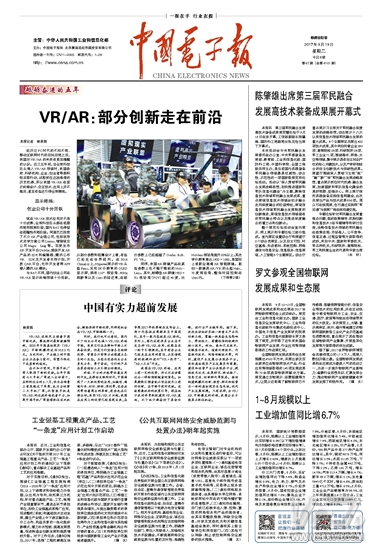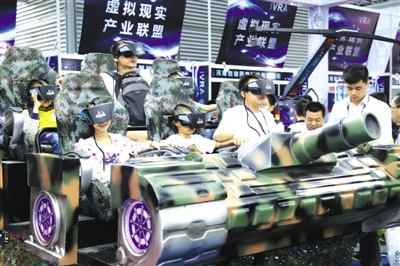After experiencing the unknowingly of the PC era and the aftermath of the mobile Internet era, China has become more aware of the future of VR/AR. In the past three to five years, when global technology giants poured into the VR/AR field, Chinese government, scientific research institutions, enterprises, and entrepreneurs all took active measures to try to seize this wave of historic opportunities, so our country's VR/AR is showing Terminal design, interactive technologies, and applications are not backward, and some even lead the global trend.

The application of VR/AR technology is not very mature. The global technology giants are in the early stages of deployment and exploration. The domestic BAT also stays in the forward-looking layout stage. Alibaba has invested in a number of AR industry chain companies, including Lumus, a waveguide optics company, and Magic Leap, an augmented reality company. Baidu released the AR development platform DuMix, which provides SDKs and editors for developing AR products. Tencent announced VR SDK and developer support plans, and opened QAR platform to allow developers to connect APPs to Tencent AR modules.
Unlike BAT, domestic startups are very active in the field of VR/AR display terminals. From the perspective of some parameters and light and thin design, some have already taken the lead in the world. At 2016 ChinaJoy, Hypereal demonstrated the VR helmet Pano, which uses a 2K resolution OLED display with a 110° field of view angle, a 90Hz refresh rate, and an 11ms delay rate. It has surpassed the Oculus Rift and PS VR in some parameters.
Similarly, China's AR glasses products are not lost to Microsoft's HoloLens in certain parameters. Among them, Nedex AR glasses NED + X1 field of view angle (FOV) more than 40 degrees, more than 20% increase in the angle of view than Hololens; its optical resolution up to 1920 × 1080, is the world's first full HD AR glasses. A shadow helmet with Halo, AR/VR, a 70-degree field of view, and an overall delay of 13ms.
From the light and thin design point of view, our country VR/AR glasses have already taken the lead in the world. Multi-V1 smart glasses only weigh 88g, thickness 16mm, equipped with 2K HD resolution, to achieve a 105 degree viewing angle field. The weight of the Seengene X1 is 166g, which is 410g lighter than that of the HoloLens.
And our virtual reality glasses have been applied to the aerospace field. The virtual reality glasses developed by the China Astronaut Research and Training Center and Beijing Institute of Technology were successfully applied to the psychological relief of the astronauts in the 33-day “space journeyâ€.
In addition, the Virtual Reality Industry Alliance (IVRA) has released the "General Specification for Virtual Reality Head-mounted Display Devices." This is the first self-developed standard in China's virtual reality field and will play an important role in regulating the market and guiding the sound development of the industry. .
Interactive Technology: Technology and Ideas Are at the ForefrontIn interactive technology, Chinese enterprises have already taken the lead in the world. TPCAST ​​is the world's first wireless VR display commercial product. This device solves the problem that HTC Vive has been bound by cables. It can support 2K@90Hz HD content, the transmission speed can reach 3.5GB/s, and the minimum delay can reach 15ms.
Qixin Yiwei is China's first technology company with independent intellectual property rights eye tracking and eye movement control technology. Last year it released the world's first VR eye tracking module aGlass. Its tracking range is vertical 30° and horizontal 50°, tracking speed up to 380Hz, tracking accuracy less than 0.5°, delay less than 5ms. Zhang Jianzhong, the vice president of NVIDIA and the general manager of China, believes that Qixin Yiwei’s eye tracking technology surpasses other global technology companies.
Hypereal's self-developed laser positioning solution allows the user to accurately position the head and two-hand controls (in millimeter accuracy) within a 30 square meter range.
There are Ximmerse and Nuo Yiteng. The former has VR input control devices MACE, VR universal mobile platform Teleport, and optical gesture tracking devices and haptic feedback devices. The latter developed an internationally leading level of "motion capture technology based on MEMS inertial sensors", and on this basis formed a series of low-cost high-precision motion capture products with completely independent intellectual property rights.
In addition, the breakthrough in the theory of interactive technologies in China also deserves attention. The Human-Computer Link Laboratory of Sun Yat-sen University proposed the concept of “Expanded Reality†(“Expanded Realityâ€), which is the first of its kind in the industry. The integration of VR and IoT samples not only enables you to experience, but also real-time operation of physical processes. Using the master-slave robot control system between the first site and the second site to represent the first stage of the device connection technology in future VR and IoT, it is proved in principle that people living in networked VR do not need to escape from immersive virtual The environment can complete substantive production tasks.

In terms of light field technology, Transit Digital Technology (Shanghai) Co., Ltd. not only pioneered the combination of light and field shooting systems, but also achieved high-precision modeling of light field three-dimensional devices. The combined light and field acquisition system includes 80 dynamic PointGray cameras and 80 static Canon SLR cameras, which can simultaneously collect the reflected light from the same object surface from 360 degrees. Dynamic camera resolution of not less than 2K, mainly used for real-time modeling of dynamic deformation of objects; static camera resolution of not less than 2K, mainly used to achieve high-quality surface reflection characteristics of the acquisition; single-frame shooting cumulative acquisition and processing of light reaches One billion. Using the unique backlit optical field backtracking algorithm, real-time dynamic geometric information and high-quality static light information can be fused together, so that a dynamic non-rigid model can also be reconstructed with high quality. At present, similar technologies in the world can only choose between high quality and high frame rate. However, the static and dynamic light field acquisition system in superimposition breaks this limitation and realizes independent innovation in VR light field technology in China. breakthrough.
The accuracy of modeling and reconstruction of the three-dimensional device of the light field of the superimposed digital is sub-millimeter. At the same time, the end-to-end system from the light field acquisition to the light field model rendering is realized, and the degree of manual intervention is reduced by 70%. At the same time, the superposition of light field compression technology has also been vigorously developed. When the compression ratio reaches 500:1, the PSNR of the compression quality still remains over 30dB, and the codec rate reaches 30fps, which reduces the bandwidth requirement and allows the mobile terminal to experience smooth light. Field VR, to achieve a true sense of "mobile VR."
Similarly, Tsinghua University has been exploring the light field technology for many years and has developed a large-scale light-field camera system consisting of 60 camera arrays and more than 800 LED lights, which can improve the accuracy of VR content according to changes in lighting. Keep high-frequency information and obtain low-frequency information. The system has been applied in Hangzhou and other places. Large-scale light field cameras are expensive and difficult to use, and they are mainly used in professional fields. However, the development of the VR industry is more consigned to the consumer market. Popularized collection equipment and convenient content generation methods have become more urgent needs. Prof. Dai Qionghai of Tsinghua University revealed that their team has used Microsoft hardware solutions to make a thousand-level light field camera. Unlike the large-scale light field system, its accuracy is low, but it can perform dynamic and static objects. Real-time 3D reconstruction will be marketable by the end of 2018.
Industry Applications: New breakthroughs in VR/AR+ medical and constructionIn key applications, Chinese universities and scientific research institutions have successfully applied VR technology to military, medical, and construction fields, and some have reached the world's advanced level. The VSV visual simulation system of Peking University is the only visual system that is independently coded in China and has basically reached the world-class level. The VSV visual simulation system consists of functional modules such as a landscape data organization and distribution scheduling service system, a three-dimensional scene dynamic organization and drawing management system, a scene rendering engine, a physical simulation engine, and a three-dimensional visual simulation generation system. Its rendering engine supports real-time rendering of tens of thousands of lights per frame, and can realistically simulate global dynamic oceans, atmospheric scattering, light changes, storms and other special effects. The system drawing frame rate can reach more than 60FPS, can fully meet the real-time dynamic interaction requirements of flight simulation simulation system.
Beijing University of Aeronautics and Astronautics has developed a percutaneous coronary angioplasty (PCI) simulator that supports personalization. The PCI surgery simulator has a precision of more than one million masks for the main organs of the cardiovascular structure and the heart, more than 100,000 physical computing units, a visual simulation frequency of 30 frames per second, and a relative force feedback error of 5 %, the calculation efficiency of the virtual collision force reaches 1000Hz.
According to reports, the function and performance indicators of the PCI surgical simulator have reached the advanced level of similar commercial products abroad, with high calculation efficiency, high precision, good robustness, etc., and can closely combine personalized surgical rehearsal with simulation training. , can provide more training cases for doctors, to minimize the risk of clinical surgery.
The R&D team formed by Taiwan’s Qinyi University of Science and Technology and Xiuchuan Hospital published the results, saying that its “MR+VR smart medical glasses†developed on the basis of MR hybrid virtual reality glasses combined with VR virtual reality and data gloves data gloves Other technologies allow doctors at the remote site to guide disaster site personnel to perform surgery or first aid on the injured person in real time. At present, two clinical trials have been completed. The next step will be to gradually enter the application testing and mass production phase.
The Graphic Research Center of the School of Software, Tongji University has developed a Smart_Web3D_BIM visualization service platform based on lightweight BIM (Building Information Modeling). This platform has broken through the lightweight Web3D-BIM key technologies (lightweight preprocessing, fine-grained preprocessing, progressive transmission, incremental web-level rendering processing, etc.) and successfully placed large-scale BIM scenarios on the mobile Internet. Users do not need to download and install any plug-ins, and simply click on a webpage to easily browse online (even those large-scale BIM scenarios that are difficult to open and view on a single machine, such as Revit, etc.). This technology enables the planning, design, construction, verification, maintenance, completion, and operation of smart cities to be "integrated" organically in the mobile Internet through lightweight BIM visualization technology, realizing "Internet+", "VR+" and " The integration of BIM+'s application has a bright future.
Local governments: scrambling to create "VR capital"In the past two or three years, a number of VR incubators have emerged. Especially last year, Fuzhou, Fujian, Nanchang, Jiangxi, Laoshan, Qingdao, Hunan, Changsha, and Jiaxing, Zhejiang Province announced high-profile announcements of the establishment of a VR industrial base, which will create a "VR capital."
Nanchang City issued the "Preferential Policy on Accelerating the Construction of Virtual Reality VR Industry Base in Nanchang City."
The Fuzhou Municipal Government issued the "ten measures to promote the accelerated development of the VR industry".
In addition to Fuzhou, Nanchang, and Laoshan Districts, Beijing’s Zhongguancun, Huangguoshu, Chengdu, Hefei, Anxi, and Xixiu District of Anshun City have either established VR industrial bases or are planning to build them, and this momentum is heading towards a broader region of the country. spread.
They not only stayed in the slogan but also established various VR industry funds. Laoshan District will establish the first phase of the VR industry guidance fund of 5 billion yuan. Nanchang has established 1 billion yuan of angel venture capital funds and 10 billion yuan of industrial funds. Changsha established a VR Industry Fund with a first-phase fund of RMB 3 billion. The VR Township of East Lake in Fujian Province has established a VR and innovative industrial parent fund with an initial scale of RMB 3 billion. Ji'an, where VR/AR town of Beidouwan is located, has announced ten policies to support the development of the VR industry. Zhejiang Jiaxing has issued the “Ten Article†of special policies for virtual display and visualization industry. It provides policy support for the development of VR/AR industry from the aspects of overall coordination, administrative simplification, direct information access, financial support, talent introduction, and industrial guidance.
This article comes from the China Electronics News, author Lin Meibing. Scan the QR code to pay attention to the official WeChat public number of the VR network and get more information about the VR/AR industry.

Butt Connector,Lugs Insulated Female Connectors,Insulated Female Connectors,Non-Insulated Spade Terminals Wire Connector
Taixing Longyi Terminals Co.,Ltd. , https://www.longyicopperterminals.com